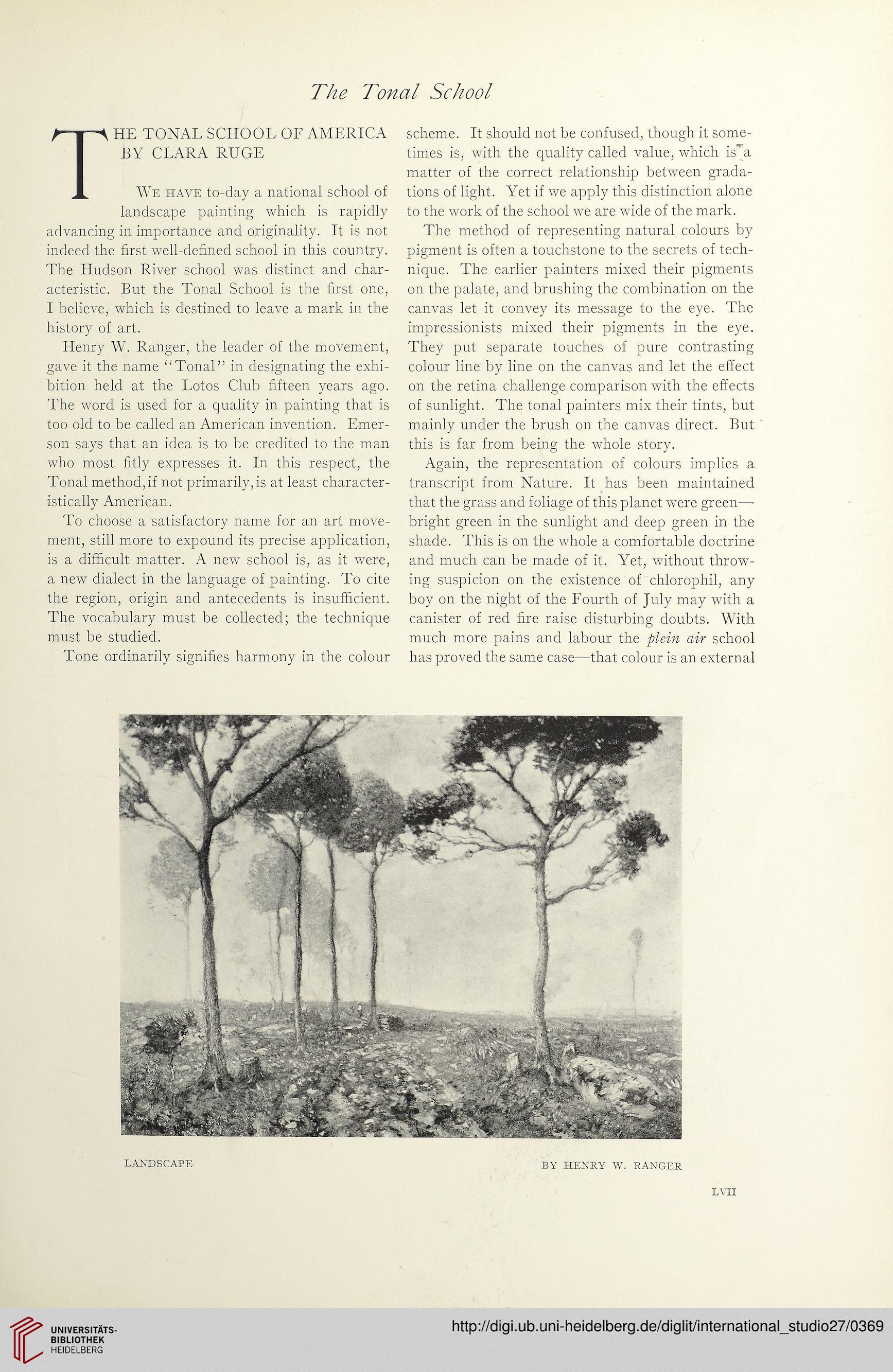The Tonal School
T
HE TONAL SCHOOL OL AMERICA
BY CLARA RÜGE
We have to-day a national school of
landscape painting which is rapidly
advancing in importance and originality. It is not
indeed the first well-defined school in this country.
The Hudson River school was distinct and char-
acteristic. But the Tonal School is the first one,
I believe, which is destined to leave a mark in the
history of art.
Henry W. Ranger, the leader of the movement,
gave it the name “Tonal” in designating the exhi-
bition lield at the Lotos Club fifteen years ago.
The word is used for a quality in painting that is
too old to be called an American invention. Emer-
son says that an idea is to be credited to the man
who most fitly expresses it. In this respect, the
Tonal method,if not primarily, is at least character-
istically American .
To choose a satisfactory name for an art move-
ment, still more to expound its precise application,
is a difficult matter. A new school is, as it were,
a new dialect in the language of painting. To eite
the region, origin and antecedents is insufficient.
The vocabulary must be collected; the technique
must be studied.
Tone ordinarily signifies harmony in the colour
scheme. It should not be confused, though it some-
times is, with the quality called value, which is^a
matter of the correct relationship between grada-
tions of light. Yet if we apply this distinction alone
to the work of the school we are wide of the mark.
The method of representing natural colours by
pigment is often a touchstone to the secrets of tech-
nique. The earlier painters mixed their pigments
on the palate, and brushing the combination on the
canvas let it convey its message to the eye. The
impressionists mixed their pigments in the eye.
They put separate touches of pure contrasting
colour line by line on the canvas and let the effect
on the retina challenge comparison with the effects
of sunlight. The tonal painters mix their tints, but
mainly under the brush on the canvas direct. But
this is far from being the whole story.
Again, the representation of colours implies a
transcript from Nature. It has been maintained
that the grass and foliage of this planet were green—
bright green in the sunlight and deep green in the
shade. This is on the whole a comfortable doctrine
and much can be made of it. Yet, without throw-
ing suspicion on the existence of chlorophil, any
boy on the night of the Lourth of July may with a
canister of red fire raise disturbing doubts. With
much more pains and labour the filein air school
has proved the same case—that colour is an external
LANDSCAPE
BY HENRY W. RANGER
T
HE TONAL SCHOOL OL AMERICA
BY CLARA RÜGE
We have to-day a national school of
landscape painting which is rapidly
advancing in importance and originality. It is not
indeed the first well-defined school in this country.
The Hudson River school was distinct and char-
acteristic. But the Tonal School is the first one,
I believe, which is destined to leave a mark in the
history of art.
Henry W. Ranger, the leader of the movement,
gave it the name “Tonal” in designating the exhi-
bition lield at the Lotos Club fifteen years ago.
The word is used for a quality in painting that is
too old to be called an American invention. Emer-
son says that an idea is to be credited to the man
who most fitly expresses it. In this respect, the
Tonal method,if not primarily, is at least character-
istically American .
To choose a satisfactory name for an art move-
ment, still more to expound its precise application,
is a difficult matter. A new school is, as it were,
a new dialect in the language of painting. To eite
the region, origin and antecedents is insufficient.
The vocabulary must be collected; the technique
must be studied.
Tone ordinarily signifies harmony in the colour
scheme. It should not be confused, though it some-
times is, with the quality called value, which is^a
matter of the correct relationship between grada-
tions of light. Yet if we apply this distinction alone
to the work of the school we are wide of the mark.
The method of representing natural colours by
pigment is often a touchstone to the secrets of tech-
nique. The earlier painters mixed their pigments
on the palate, and brushing the combination on the
canvas let it convey its message to the eye. The
impressionists mixed their pigments in the eye.
They put separate touches of pure contrasting
colour line by line on the canvas and let the effect
on the retina challenge comparison with the effects
of sunlight. The tonal painters mix their tints, but
mainly under the brush on the canvas direct. But
this is far from being the whole story.
Again, the representation of colours implies a
transcript from Nature. It has been maintained
that the grass and foliage of this planet were green—
bright green in the sunlight and deep green in the
shade. This is on the whole a comfortable doctrine
and much can be made of it. Yet, without throw-
ing suspicion on the existence of chlorophil, any
boy on the night of the Lourth of July may with a
canister of red fire raise disturbing doubts. With
much more pains and labour the filein air school
has proved the same case—that colour is an external
LANDSCAPE
BY HENRY W. RANGER





